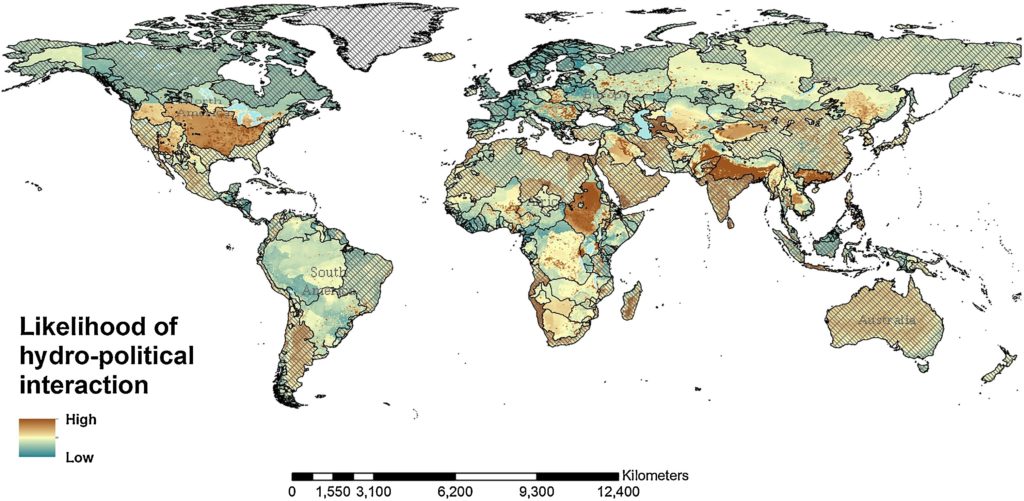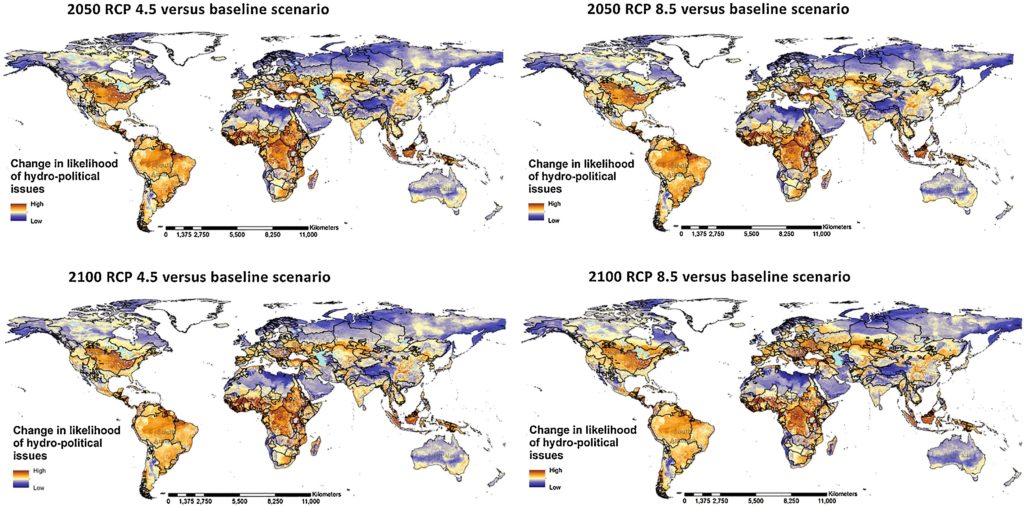Hydro-political Interactions
Transboundary waters are of critical importance in global politics, with 286 shared watercourses between 146 countries. Climate change and population growth are expected to heighten hydro-political tensions, leading to increased water related interactions in these transboundary river basins.
Featured analysis
Mapping an index of potential future transboundary water interactions can help identify conflict prone areas in need of water cooperation.
In this analysis, an index is built up by:
1) identifying pre-conditions of water management issues, by examining past conflicts and cooperation over shared water resources,
2) building a Random Forest regression model using the identified preconditions, including freshwater availability, climate stress, human pressure on water resources, socioeconomic conditions and topographic characteristics
3) calculating the index both for current climatic and socioeconomic conditions (baseline) and for future climate and population projections.
Definition of a hydro-political interaction
- Interactions can involve either tensions or cooperation; either way, they indicate a water allocation or management issue
- Although the index doesn’t give information about the degree of cooperation or conflict associated with the specific interaction, it identifies areas of possible hydro-political risk that would be best addressed through cooperative action.
Interpretation
- Likelihood of hydro-political interactions is expressed in relative terms across basins. The values are normalized across the basins into a 0 – 1 range (high values corresponding with a higher likelihood of hydro-political interactions).
- The likelihood of hydro-political interactions is influenced by time-invariant factors such as geographical and topographical characteristics and time-varying factors such as climatic and socio-economic characteristics.
- When water related interactions occur, we expect:
- Water related issues are more likely resolved with cooperation than conflict
- Cooperation is higher when water scarcity is moderate rather than extreme, and where there is institutional stability as well as effective past agreements oriented towards a fair and efficient water allocation.
Main takeaways
- The index highlights the areas where issues related to water resources are most likely. Some of the areas highlighted are well known hotspots that are already stressed, such as the Ganges-Brahmaputra basin, the Nile basin, the Indus basin and the Euphrates-Tigris basin.
- The likelihood of hydro-political interactions is expected to rise on average between 74.9 % (2050 RCP 4.5) to 95.3 % (2100 RCP 8.5) especially in sub-Saharan Africa, South-America, Southern North-America, Southern and Eastern Europe, Central and Southern Asia.
- Hydro-political interactions were more likely in:
- Areas with low to medium levels of national power
- Very upstream and very downstream countries
- Rural and agricultural dependent economies and lower to middle income countries
- The most relevant factors in determining hydro-political interactions were represented by: population density, water availability, upstream/downstream dynamics, territorial and power imbalance and climatic conditions.
- Increasing population density is a major, but non-linear driver, by increasing human pressure on a limited set of resources
Key assumptions
- The results are only intended as a screening analysis for areas that might require closer investigation now or in the future
- The data selected was limited by availability; the analysis could be improved with more data on socioeconomic, institutional, biophysical and demographic projections could improve the analysis
- Event data was obtained by searching international and local news, but only in English, and only related to bilateral country interactions over a 10 year period
Possible future work
- Further work to help move away from recording data to understanding of phenomena and mechanisms behind them, which are prerequisites for identification of effective sustainability policies.
- Finer scale analysis, at regional or sub-regional contexts, especially in developing countries, which are characterised by rapid population growth and unsustainable development and heavy effects of climate change on water availability.
Hydro-political interactions
Exploring conditions in which water-related issues arise can help to identify potential future hotspots
Further reading
- An innovative approach to the assessment of hydro-political risk: A spatially explicit, data driven indicator of hydro-political issues (2018)
- Publications tagged with: ‘water stress’
- Publications on ‘hydro-political risk‘
Contact
Contributed by:
- Fabio Farinosi, European Commission Joint Research Centre
- Summary written by Erik Salminen, Aalto University
Submit a topic?
Have you done research related to water scarcity? Send us some information and we may publish your research in the Water Scarcity Atlas. Please email us at info@waterscarcityatlas.org
Feedback
Want to give us a feedback? Send us an email at info@waterscarcityatlas.org

